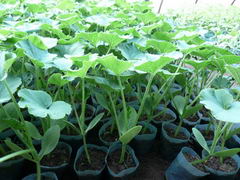Watermelon green mottle mosaic disease
In recent years, in most areas of Liaoning, with Gai County as the center, the vast number of watermelon growers have a headache. When the harvest is about to be achieved, it is found that the flesh of the watermelon with a good appearance has gone bad-- the commodity value in the shape of "frozen heart" and "inverted clover" has been greatly reduced, and the farmer friends are miserable. "Why does the watermelon I grow have such a serious' frozen heart disease'? What kind of disease is that? How can we avoid getting sick? " Such a problem has once made us a headache as a seed management department, and we have always wanted to solve this problem for farmers and let farmers get high income. After multi-party consultation, with the help of provincial and municipal plant protection departments, we finally found the answer, and have a deep understanding of the disease, and now introduce the situation of this disease to the majority of farmers. Hope to help farmers solve this headache problem. The scientific name of "frozen heart disease" is watermelon green mottle mosaic disease, and farmers call it "frozen heart flesh" because of its performance. The pathogen of this disease is Cucumber green mottle mosaic virus (CGMMV-W cucumber green mottle mosaic virus). Watermelon green mottle mosaic disease is mainly transmitted through seeds (watermelon and rootstock seeds), soil, plant sap, grafting process and agricultural operation. 1. Seed transmission the infection rate of watermelon seeds collected from diseased plants is about 1%, and the infection rate of grafted rootstock gourd is 1%, 6%. This shows that if poisonous seeds are used, the chance of contracting the disease will be quite high. If there are suitable conditions, the virus on the seed coat can be transmitted to the cotyledons, and the young leaves can show symptoms after 21 days. Second, soil transmission occurs in continuous cropping melon orchards, and the virus survives the winter in the remnants of the diseased plant. The soil still has pathogenicity for one year and two months, and it becomes the source of infection in the second year. The soil virus-carrying rate is 0.5%. 3. although the seed infection rate is relatively low compared with the field incidence, it is very easy to be transmitted through field contact, such as grafting, transplanting, tending, ploughing and other agricultural operations; if there is strong wind and rain in the field, it causes plants to collide with each other, branch and leaf friction, and virus sap is transmitted by wind and rain, and the disease is more serious in the environment of high temperature and humidity. The disease is also serious in the high temperature of the shed. Knowing the onset conditions and transmission routes of this disease, how can we judge its symptoms? Watermelon green mottle mosaic disease mainly damages leaves, fruit stalks and fruits. ⑴, seedling infection: irregular chlorosis (green mottled) and brown flowers and leaves appeared on the new leaves. When the disease was serious, the green part of the leaves were raised and uneven, and the leaves became thinner and smaller. In the seedling stage, the virus has completed the whole life cycle infection process, showing obvious symptoms, which is easy to detect. (at this time is also the most important link of prevention and control). ⑵, growth period: infected plants, vine growth is poor, plant growth is not luxuriant. Mosaic symptoms were not obvious in old leaves and mature leaves, but slightly yellow compared with healthy leaves. (at this time, the symptoms are not obvious and are not easy to detect. )
Related
- A course of planting techniques and methods on how to grow carrots
- How to plant the latest tulips?
- Is it better to pick tea in the morning or in the afternoon? When is the best time for tea to be picked? what is the third or fifth tea?
- Launch Yuanxiao Happy combination Haocha + Tea Yuan healthy Taste
- Penghu Tourism "Fireworks 20 Parade with You"
- 2022 West Lake Happiness holds "Digital Revitalization Voucher" and draws iphone13 and laptop.
- Banqiao Fuzhou social houses are designed to change start-up combined with police elimination to create a safe and livable environment
- The convenient measure of "mechanical weeding" in Xinbei has been abused and the Agriculture Bureau has imposed heavy penalties on the illegal land consolidation.
- Changgeng University Joins Hands with Four Memory Factories to Rescue Memory Talent Shortage
- The list of Taiwan's top 100 MVP managers is listed by the Director-General of the Farmers' Association of Sanxia District.



